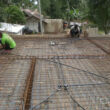Each type of floor has its own merits and there is not even a single type which can be suitably provided under all circumstances, and more so when floors have to serve different purposes in different types of buildings.
Therefore before final selection of any type of flooring one must know the functional requirements that must exist in any floor system.
Keeping in view of its importance, today i will talk about the requirements and functions which must be there in a good floor system.

Properties of a good flooring system for your home
1. Initial Cost.
The cost of construction is very important in the selection of type of floor. A floor covering of marble, granite, special clay tiles, etc. is considered to be very expensive, whereas a flooring of cork, slate, vinyl tile, etc. is moderately expensive. The floors made of concrete and brick offer the cheapest type of floor construction. It should be ensured during the comparison of cost for different floors that the cost of both covering and sub-floor has been accounted for.
2. Appearance calc
Flooring should produce the desired color effect and architectural beauty in conformity with its use in the building. Generally, flooring of terrazzo, tiles, marble and cement mortar provides a good appearance whereas the asphalt covering gives an ugly appearance.
Also Read: 7+ Different Floor and Flooring Types
3. Cleanliness
A floor should be non-absorbent and capable of being easily and effectively cleaned. All joints in flooring should be such as to offer a watertight surface. Moreover, greasy and oily substances should neither spoil the appurtenance nor have a destroying effect on the flooring materials.
4. Durability
The flooring material should offer sufficient resistance to wear and tear, temperature, chemical action, etc. so as to provide long life to the floors. From the durability point of view, flooring of marble, terrazzo, tiles and concrete is considered to be of the best type. Flooring of other materials such as linoleum, rubber, cork, bricks, wood blocks, etc. can be used where heavy floor traffic is not anticipated.
Also Read: Stilt Floor – Level – Meaning [a COMPLETE GUIDE]
Like Us on Facebook!
5. Damp-resistance
All the floors, especially ground floors, should offer sufficient resistance against the dampness in buildings to ensure a healthy environment. Normally, floors of clay tiles, terrazzo, concrete bricks, etc. are preferred for use where the floors are subjected to dampness.
Subscribe Us on YouTube!

6. Sound Insulation
According to modern building concepts, a floor should neither create noise when used nor transmit noise. Sometimes, it is required that any movement on the top floors should not disturb the persons working on the other floors. Suitable flooring is provided which is somewhat noiseless when traveled over.
7. Thermal Insulation:
It should be possible for a building to maintain constant temperature or heat the inside the building irrespective of the temperature changes outside. Thermal insulation is needed to reduce the demand of heating in winter and refrigeration in summer. It is important in the case of wooden floors where heat losses are considerable and in solid floors with heating pipes or cables where the heat looses at the edges of the floor slab can be higher. Floors of word, corck, etc. are best suited for this purpose.
8. Smoothness:
The floor covering should be of superior type as to exhibit a smooth and even surface. However, at the same times, it should not be too slippery which will otherwise endanger safe movements over it, particularly by old people and children.
9. Hardness:
It is desirable to use good quality floor covering, which do not give rise to any form of indentation marks, imprints, etc. when used for either supporting the loads or moving the loads over them. Normally, the hard surfaces rendered by concrete, marble, stone, etc. do not show any impressions, whereas the coverings like asphalt, cork, plastics, etc. do form marks on the surfaces when use in traffic.
10. Maintenance
It is always desired that the maintenance cost should be as low as possible. Generally, a covering of tiles, marble, terrazzo or concrete requires less maintenance cost as compared to the floors of word blocks, cork, etc. it should, however, be noted that the repairing of a concrete surface is more difficult than the flooring of tiles, marbles. Etc.
Further Read: 7 Tips To Create Basic But Functional Floor Plans

















